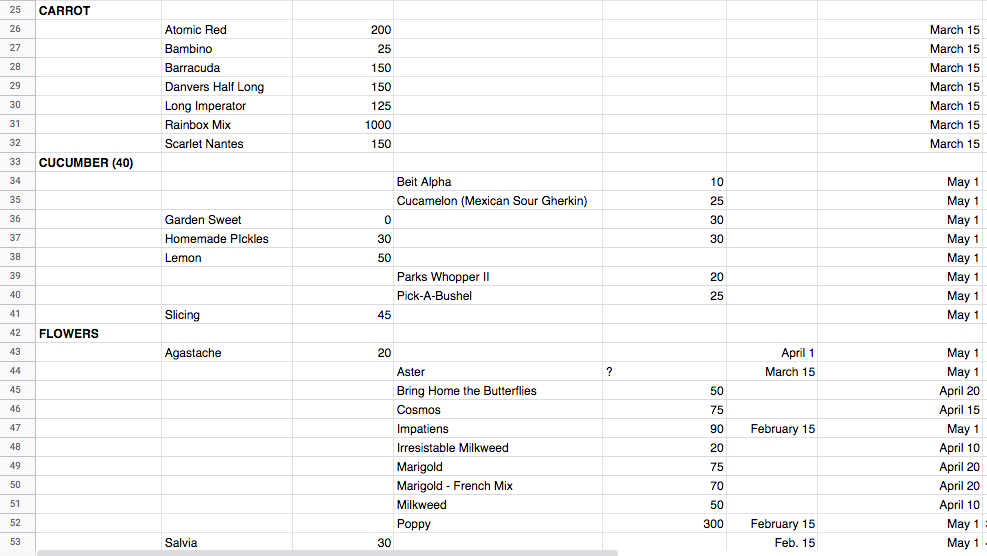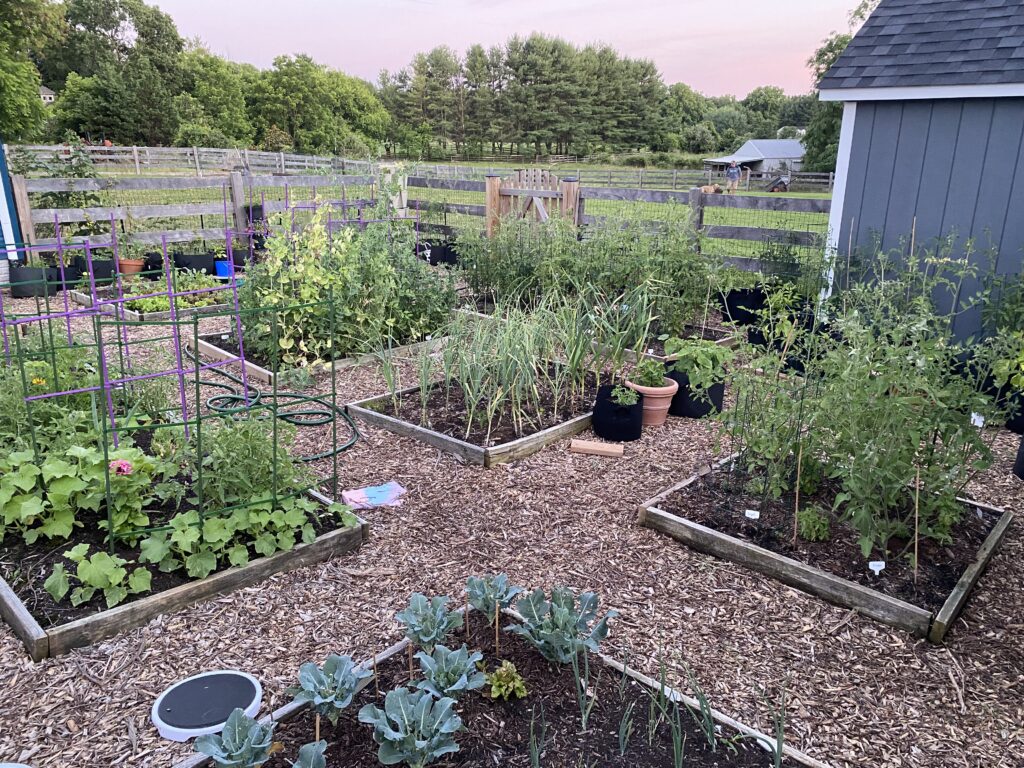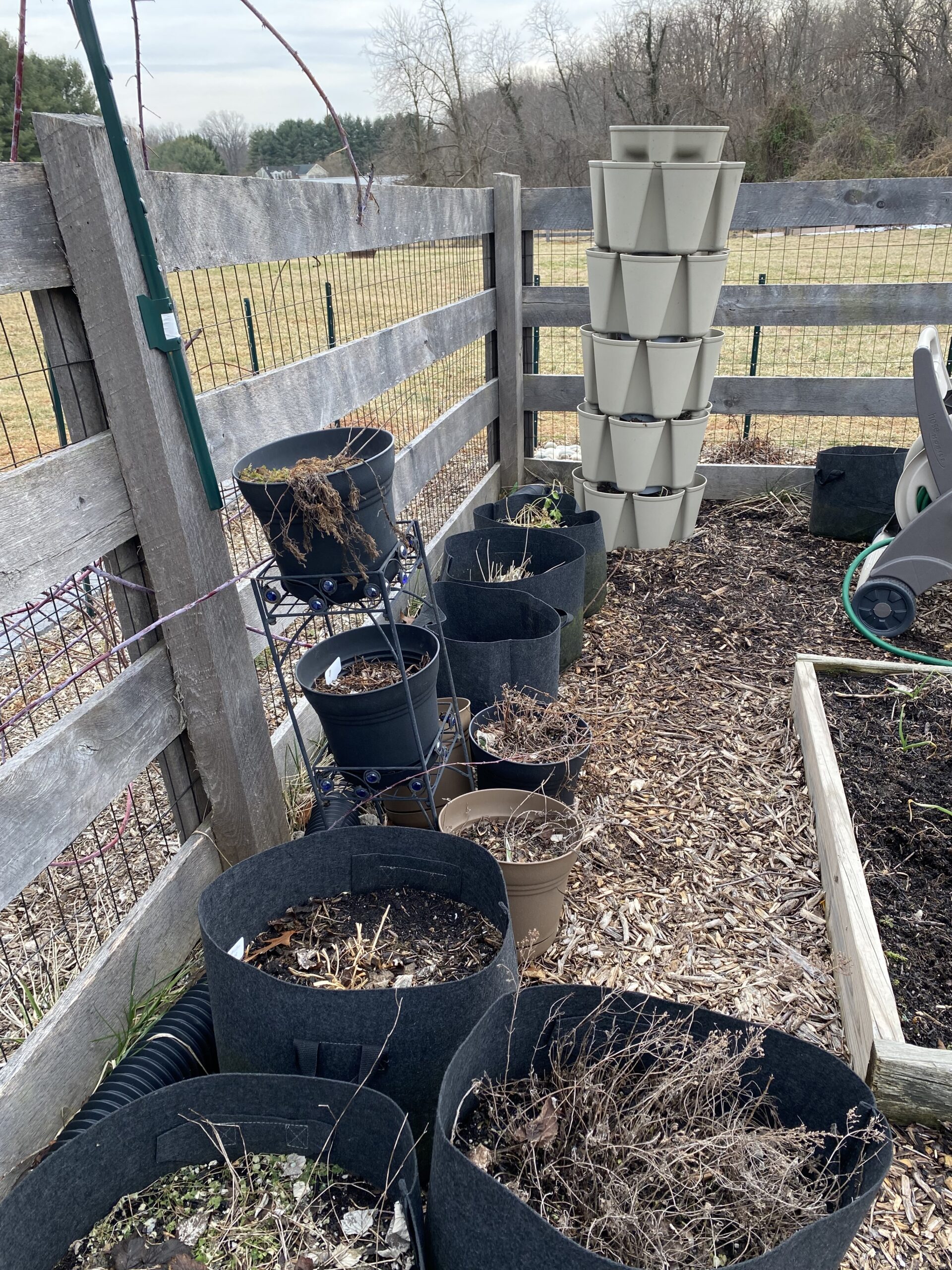Those of you that know me well, know that I really like to plan.
When I am having people over, I plan out each minute to get ready for the event and then I check off the list as I go (Yeah, I know how that sounds).
Gardening is no different. I have already planned out all of 2022.
I thought I’d share my process and how I’m able to make the most of my space and get multiple harvests throughout all of the seasons.
If you do something different, PLEASE share! I’m always looking for ways to tweak my planning process to make my gardens the best they can be.
Full disclosure: The pictures in this post aren’t nearly as exciting as in my previous posts. Unless, of course, you have a type-A personality like me.
First things first:
What do you want to grow?
The first thing I do is write down all of things that I want to grow. Even if I don’t think that it is possible, I write it down. I make sure to include any herbs and flowers in my list.

I think about any varieties that I know exist and if I want to grow them. For instance, I knew I wanted to grow several types of basil.
This list can be as long as you want. You can always take things off it later.
Where do you put them?
Then I analyze my space. The last couple of years we’ve added some extra beds so I include those spaces even though I don’t have them yet.




Think about anything that would be a perennial because they would need a permanent space. Perennials could include strawberries, anything in the mint family, berry bushes, rosemary and other herbs, and some flowers.
You want to be careful adding perennials into your raised bed garden space. If you don’t have a big space, I would recommend planting any perennial plants in a dedicated container or a different spot in your yard.


Another thing to consider when figuring out how much space you have is that some plants need more space than others.
Tomatoes need about 1.5-2 feet between them. However, radishes can be about 4 inches apart. So if you have a 6’x4′ raised bed, you can only put about 6 tomato plants in that bed but you could put about 250 radishes (whoa thats a lot of radish).
When do you plant them?
At this point, I do a little research about when I should plant each item in the zone/climate that I live in. This helps me to decide how long I can use the space that I have and when it will be free.

For example, I will plant garlic in mid-October. Garlic takes a good 9 months grow in my climate.


I won’t harvest all of the garlic until about mid-July the following year. So I take a look at what I have that can grow in my garden after garlic. Last year, I ended up planting an entire bed of green beans. It was perfect and I ended up with hundreds of beans just from that planting. This year I am considering doing a fall planting of carrots after my garlic. We’ll see how it works out.
Another example would be my spring/cool season crops. I will plant radishes and peas starting in mid-March to early April. Since both of these crops will be done before the heat really sets in, I could get a full summer season crop in those beds. This year I plan on adding some zucchini and heat tolerant lettuce after I’ve harvested my peas and radishes. Utilizing the space this way helps me to get multiple harvests from the same space.
I want to note that I plan all of this now. Having this plan early on in the year helps me to stay on track and not play the guessing game in the middle of the growing season. I even have my fall and winter garden already planned. Also, I’m the kind of person that if I don’t write it down or its not all planned out…. I won’t do it.
Companion planting
This is something that I tried my first year with moderate success. Basically, companion planting is when you plant two or more different vegetables/fruits in the same space and they help each other out with either vertical support, pest management, or a host of other things.
This gets complicated fast but if you want to do it, plan it now. And I highly suggest making sure that two plants will not harm each other.
Take for instance my tomato/radish scenario. If you were to plant tomatoes in a row that blocked the sun for the radishes, they might not grow well enough. Or maybe even the opposite. Since radishes are cool weather crops, maybe they could benefit from the cooling shade in the height of the summer heat.
There’s definitely a lot to consider here with companion planting.
My favorite way to companion plant is with flowers and annual herbs. I like to add all kinds of flowers between my crops and my many different types of basil.




Planting flowers between many of my edible plants had a few wonderful side-effects. First, they looked beautiful. It made the garden so much more colorful and much earlier than normal. And second, they brought in way more of those beneficial insects.

I plan all of this out too. Makes life easier for me when I am transplanting 250-300 plants.
Containers
One thing that I try to consider is my containers. I have many different kinds including regular pots, grow bags, rectangle planters, and a GreenStalk.

When I inevitably run out of space in my raised beds, I look to my containers to help supplement my space.

The planning for these containers is something that should be done now. But I’ll be honest, I have so many containers, I’ll just see how many plants I end up with and place them accordingly.
I will say that I plan to have extra soil on hand for when I do need those containers though.
Indoor seed starting or buying transplants
At this point I have to see which plants I want to start indoors as seeds and which ones I would rather buy at a local garden center.
I plan the exact dates of when I would need to sow seeds indoors and when they would be ready to transplant outside.

This makes my life SO much easier to schedule it all out.
Analyze what seeds I have and what I need to buy. Beware of seed catalogs.
The last thing that I will do is inventory all of my seeds and buy the ones that I need.
If I know I have 20 spots for tomato plants, then I will buy enough seeds to cover those 20 spots. If I have 5 different types of seeds, I’ll plant 4 of each.
When buying your seeds beware of seed catalogs.
Some of them as absolutely beautiful but they draw you in and you can’t get back out.
Seed catalogs are the Toys R Us catalog from when we were kids but everything is $3-$4 and “it can’t hurt to buy a few more cucumber packets!”
Not saying that it’s happened to me…

I start my first seeds this weekend and I’m beyond excited. And to be honest, I’m pretty proud of myself that I didn’t start in January when I was seriously tempted to.
Hope this helps you to understand my process. I’m not saying I do any of this the right way but it helps me tremendously to be organized before I plant.
Please leave a comment and let me know how you plan out your garden. I’m always looking to learn!
Happy Almost Spring!


Beyond impressed! Rarely do I plan my garden out and never have I had anything like the yield you had last year!!! I don’t have the space and sun that you have for one, but the main problem is that I am not a planner. I’m always so intrigued to see what will come up on its own and where. Tomatoes, squash, purslane, walking onions, holi basil, mints, lemon balm, chamomile, strawberries, asparagus, aronia berry, gogi berry, lambs quarter, garlic mustard, arugula, kale, mustard, some salad greens, broad leaf plantain, garlic chives, coneflower, bee balm, borage, comfrey, nasturtium, sorrel, fiddle head fern, elderberry – really just a mix of edible perennials and weeds and self seeding veg’s, but these are the things I can count on to come back with no effort or planning on my part and most interesting is that these plants move around on their own and eventually find a spot that has what they need to thrive. Of course I don’t get the yield that you do with this lackadaisical method of gardening, but it is what I have time and inclination for. I will start tomatoes – I like Black Krim too – tastiest tomato ever IMO – zinnias, can never have too many, peppers, cucumbers, soy beans, green beans, squash from seed and fit them in where I can. I love Korean white sweet potatoes and purple potatoes. I grow slips from organic sweet pot from the grocery store and will get seed potatoes. I’ve never had any success growing melons, have never experienced an abundance of squash mostly because I don’t get stuff in the ground at the right time. But, there is abundance enough over all to freeze and can and share and add delight and extra nutrients and diversity to our diet, and bouquets for the table. I have really changed the micro climate of my yard with significant increase in pollinators and birds, dramatically transformed soil quality over 14 years, not to mention plant diversity. It is immensely satisfying failures and all. So impressed with your gardening! More than good enough!! You go!
Oh my gosh Katie! This is all amazing! I found that Black Krim (the best tomato hands down) was the “hardest” to germinate but absolutely worth the wait. My goal is to add more flowers this year and more variety. Have you had any success with dahlias in this climate? I’m going back and forth on whether I want to try. I’d love to come by sometime and walk your garden!